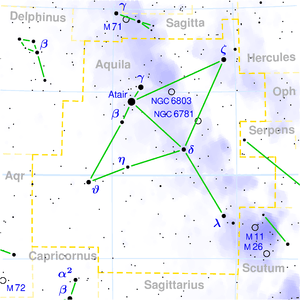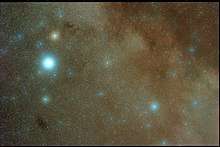Beta Aquilae
Beta Aquilae (β Aquilae, abbreviated Beta Aql, β Aql) is a binary star in the equatorial constellation of Aquila. Based on parallax measurements obtained during the Hipparcos mission, it is approximately 44.7 light-years from the Sun.
 Location of Beta Aquilae to the upper left of center | |
| Observation data Epoch J2000 Equinox J2000 | |
|---|---|
| Constellation | Aquila |
| Right ascension | 19h 55m 18.79256s[1] |
| Declination | +06° 24′ 24.3425″[1] |
| Apparent magnitude (V) | 3.87 + 12.0[2] |
| Characteristics | |
| Spectral type | G9.5 IV[3] |
| U−B color index | 0.48[4] |
| B−V color index | 0.86[4] |
| R−I color index | 0.49 |
| Variable type | Suspected |
| Astrometry | |
| Radial velocity (Rv) | −40.3±0.09[5] km/s |
| Proper motion (μ) | RA: 45.27[1] mas/yr Dec.: -481.91[1] mas/yr |
| Parallax (π) | 73.00 ± 0.20[1] mas |
| Distance | 44.7 ± 0.1 ly (13.70 ± 0.04 pc) |
| Absolute magnitude (MV) | +3.03[6] |
| Details[7] | |
| Mass | 1.26 ± 0.18[8] M☉ |
| Radius | 3.28 ± 0.15 R☉ |
| Luminosity | 6.0 ± 0.3 L☉ |
| Surface gravity (log g) | 3.60 cgs |
| Temperature | 5,100 K |
| Metallicity [Fe/H] | –0.30 dex |
| Rotational velocity (v sin i) | 0.9[8] km/s |
| Age | 9.6–11.4[9] Gyr |
| Other designations | |
Alshain, Alschairn, β Aql, 60 Aquilae, BD+06° 4357, FK5 749, GJ 771, HD 188512, HIP 98036, HR 7602, SAO 125235, LHS 5350a, LTT 15822 | |
| Database references | |
| SIMBAD | data |
| ARICNS | data |
Its two components are designated Beta Aquilae A (formally named Alshain /ælˈʃeɪn/, the traditional name for the system)[10][11] and B.
Nomenclature
β Aquilae (Latinised to Beta Aquilae) is the system's Bayer designation. The designations of the two components as Beta Aquilae A and B derive from the convention used by the Washington Multiplicity Catalog (WMC) for multiple star systems, and adopted by the International Astronomical Union (IAU).[12]
The system bore the traditional name Alshain derived from the Perso-Arabic term الشاهين, aš-šāhīn, meaning "the (peregrine) falcon", perhaps by folk etymology from the Persian šāhīn tarāzū (or possibly šāhīn tara zed; see Gamma Aquilae), the Persian name for the asterism α, β and γ Aquilae. In 2016, the IAU organized a Working Group on Star Names (WGSN)[13] to catalogue and standardize proper names for stars. The WGSN decided to attribute proper names to individual stars rather than entire multiple systems.[14] It approved the name Alshain for the component Beta Aquilae A on 21 August 2016 and it is now so included in the List of IAU-approved Star Names.[11]
In the catalogue of stars in the Calendarium of Al Achsasi al Mouakket, this star was designated Unuk al Ghyrab (عنق ألغراب - únuq al-ghuraab), which was translated into Latin as Collum Corvi, meaning the crow's neck.[15]
In Chinese, 河鼓 (Hé Gŭ), meaning River Drum, refers to an asterism consisting of Beta Aquilae, Altair and Gamma Aquilae.[16] Consequently, the Chinese name for Beta Aquilae itself is 河鼓一 (Hé Gŭ yī, English: the First Star of River Drum).[17]
Namesake
USS Alshain (AKA-55) was a United States navy ship.
Properties
The primary (Beta Aquilae A) is of magnitude 3.71 and spectral class G8IV. It has a very low level of surface magnetic activity and may be in a state similar to a Maunder minimum.[18] Since 1943, the spectrum of this star has served as one of the stable anchor points by which other stars are classified.[19] A subgiant with a mass 30% greater than the Sun's, a luminosity six times that of the Sun, and a radius about thrice solar.[20]
The secondary (Beta Aquilae B) is a 12th magnitude companion which is 13 arcseconds away in the sky. It is a class M red dwarf with a mass a third that of the Sun and a luminosity 2.5% the Sun's.
In culture
In Chinese mythology, The Princess and the Cowherd, Beta and Gamma Aquilae are children of Niulang (牛郎, The Cowherd, Altair) and Zhinü (織女, The Princess, Vega).
The Koori people of Victoria knew Beta and Gamma Aquilae as the black swan wives of Bunjil (Altair), the wedge-tailed eagle.[21]
References
- van Leeuwen, F. (2007), "Validation of the new Hipparcos reduction", Astronomy and Astrophysics, 474 (2): 653–664, arXiv:0708.1752, Bibcode:2007A&A...474..653V, doi:10.1051/0004-6361:20078357.
- Eggleton, P. P.; Tokovinin, A. A. (2008), "A catalogue of multiplicity among bright stellar systems", Monthly Notices of the Royal Astronomical Society, 389 (2): 869, arXiv:0806.2878, Bibcode:2008MNRAS.389..869E, doi:10.1111/j.1365-2966.2008.13596.x.
- Gray, R. O.; et al. (July 2006), "Contributions to the Nearby Stars (NStars) Project: spectroscopy of stars earlier than M0 within 40 pc-The Southern Sample", The Astronomical Journal, 132 (1): 161–170, arXiv:astro-ph/0603770, Bibcode:2006AJ....132..161G, doi:10.1086/504637.
- Oja, T. (August 1986), "UBV photometry of stars whose positions are accurately known. III", Astronomy and Astrophysics Supplement Series, 65 (2): 405–4.
- Jofré, E.; et al. (February 2015), "Stellar parameters and chemical abundances of 223 evolved stars with and without planets", Astronomy & Astrophysics, 574: 46, arXiv:1410.6422, Bibcode:2015A&A...574A..50J, doi:10.1051/0004-6361/201424474, A50.
- Anderson, E.; Francis, Ch. (2012), "XHIP: An extended hipparcos compilation", Astronomy Letters, 38 (5): 331, arXiv:1108.4971, Bibcode:2012AstL...38..331A, doi:10.1134/S1063773712050015.
- Piau, L.; et al. (February 2011), "Surface convection and red-giant radius measurements", Astronomy and Astrophysics, 526: A100, arXiv:1010.3649, Bibcode:2011A&A...526A.100P, doi:10.1051/0004-6361/201014442
- Bruntt, H.; et al. (July 2010), "Accurate fundamental parameters for 23 bright solar-type stars", Monthly Notices of the Royal Astronomical Society, 405 (3): 1907–1923, arXiv:1002.4268, Bibcode:2010MNRAS.405.1907B, doi:10.1111/j.1365-2966.2010.16575.x
- Mamajek, Eric E.; Hillenbrand, Lynne A. (November 2008), "Improved Age Estimation for Solar-Type Dwarfs Using Activity-Rotation Diagnostics", The Astrophysical Journal, 687 (2): 1264–1293, arXiv:0807.1686, Bibcode:2008ApJ...687.1264M, doi:10.1086/591785
- Kunitzsch, Paul; Smart, Tim (2006). A Dictionary of Modern star Names: A Short Guide to 254 Star Names and Their Derivations (2nd rev. ed.). Cambridge, Massachusetts: Sky Pub. ISBN 978-1-931559-44-7.
- "Naming Stars". IAU.org. Retrieved 3 March 2018.
- Hessman, F. V.; Dhillon, V. S.; Winget, D. E.; Schreiber, M. R.; Horne, K.; Marsh, T. R.; Guenther, E.; Schwope, A.; Heber, U. (2010). "On the naming convention used for multiple star systems and extrasolar planets". arXiv:1012.0707 [astro-ph.SR].
- IAU Working Group on Star Names (WGSN), International Astronomical Union, retrieved 22 May 2016.
- "WG Triennial Report (2015-2018) - Star Names" (PDF). p. 5. Retrieved 2018-07-14.
- Knobel, E. B. (June 1895). "Al Achsasi Al Mouakket, on a catalogue of stars in the Calendarium of Mohammad Al Achsasi Al Mouakket". Monthly Notices of the Royal Astronomical Society. 55: 429–438. Bibcode:1895MNRAS..55..429K. doi:10.1093/mnras/55.8.429.
- (in Chinese) 中國星座神話, written by 陳久金. Published by 台灣書房出版有限公司, 2005, ISBN 978-986-7332-25-7.
- (in Chinese) 香港太空館 - 研究資源 - 亮星中英對照表 Archived 2008-10-25 at the Wayback Machine, Hong Kong Space Museum. Accessed on line November 26, 2008.
- Andretta, V.; et al. (February 2005), "The Ca II Infrared Triplet as a stellar activity diagnostic . I. Non-LTE photospheric profiles and definition of the RIRT indicator", Astronomy and Astrophysics, 430: 669–677, Bibcode:2005A&A...430..669A, doi:10.1051/0004-6361:20041745.
- Garrison, R. F. (December 1993), "Anchor Points for the MK System of Spectral Classification", Bulletin of the American Astronomical Society, 25: 1319, Bibcode:1993AAS...183.1710G, retrieved 2012-02-04
- Kaler, James B., "ALSHAIN (Beta Aquilae)", Stars, University of Illinois, retrieved 2018-03-03
- Mudrooroo (1994). Aboriginal mythology : an A-Z spanning the history of aboriginal mythology from the earliest legends to the present day. London: HarperCollins. p. 4. ISBN 1-85538-306-3.
External links
- ARICNS
- Beta Aquilae by Professor Jim Kaler.
- Image β Aquilae
